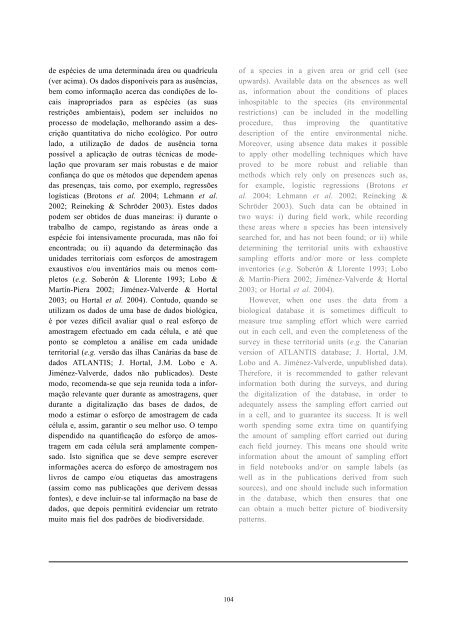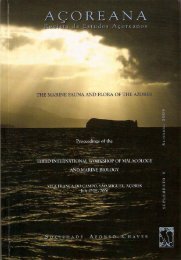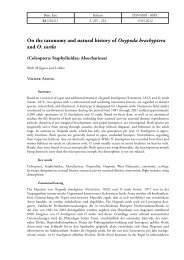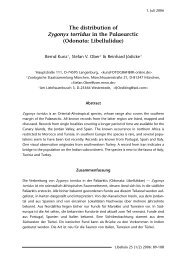(eds.) (2005). - Portal da Biodiversidade dos Açores - Universidade ...
(eds.) (2005). - Portal da Biodiversidade dos Açores - Universidade ...
(eds.) (2005). - Portal da Biodiversidade dos Açores - Universidade ...
You also want an ePaper? Increase the reach of your titles
YUMPU automatically turns print PDFs into web optimized ePapers that Google loves.
de espécies de uma determina<strong>da</strong> área ou quadrícula<br />
(ver acima). Os <strong>da</strong><strong>dos</strong> disponíveis para as ausências,<br />
bem como informação acerca <strong>da</strong>s condições de locais<br />
inapropria<strong>dos</strong> para as espécies (as suas<br />
restrições ambientais), podem ser incluí<strong>dos</strong> no<br />
processo de modelação, melhorando assim a descrição<br />
quantitativa do nicho ecológico. Por outro<br />
lado, a utilização de <strong>da</strong><strong>dos</strong> de ausência torna<br />
possível a aplicação de outras técnicas de modelação<br />
que provaram ser mais robustas e de maior<br />
confiança do que os méto<strong>dos</strong> que dependem apenas<br />
<strong>da</strong>s presenças, tais como, por exemplo, regressões<br />
logísticas (Brotons et al. 2004; Lehmann et al.<br />
2002; Reineking & Schröder 2003). Estes <strong>da</strong><strong>dos</strong><br />
podem ser obti<strong>dos</strong> de duas maneiras: i) durante o<br />
trabalho de campo, registando as áreas onde a<br />
espécie foi intensivamente procura<strong>da</strong>, mas não foi<br />
encontra<strong>da</strong>; ou ii) aquando <strong>da</strong> determinação <strong>da</strong>s<br />
uni<strong>da</strong>des territoriais com esforços de amostragem<br />
exaustivos e/ou inventários mais ou menos completos<br />
(e.g. Soberón & Llorente 1993; Lobo &<br />
Martín-Piera 2002; Jiménez-Valverde & Hortal<br />
2003; ou Hortal et al. 2004). Contudo, quando se<br />
utilizam os <strong>da</strong><strong>dos</strong> de uma base de <strong>da</strong><strong>dos</strong> biológica,<br />
é por vezes difícil avaliar qual o real esforço de<br />
amostragem efectuado em ca<strong>da</strong> célula, e até que<br />
ponto se completou a análise em ca<strong>da</strong> uni<strong>da</strong>de<br />
territorial (e.g. versão <strong>da</strong>s ilhas Canárias <strong>da</strong> base de<br />
<strong>da</strong><strong>dos</strong> ATLANTIS; J. Hortal, J.M. Lobo e A.<br />
Jiménez-Valverde, <strong>da</strong><strong>dos</strong> não publica<strong>dos</strong>). Deste<br />
modo, recomen<strong>da</strong>-se que seja reuni<strong>da</strong> to<strong>da</strong> a informação<br />
relevante quer durante as amostragens, quer<br />
durante a digitalização <strong>da</strong>s bases de <strong>da</strong><strong>dos</strong>, de<br />
modo a estimar o esforço de amostragem de ca<strong>da</strong><br />
célula e, assim, garantir o seu melhor uso. O tempo<br />
dispendido na quantificação do esforço de amostragem<br />
em ca<strong>da</strong> célula será amplamente compensado.<br />
Isto significa que se deve sempre escrever<br />
informações acerca do esforço de amostragem nos<br />
livros de campo e/ou etiquetas <strong>da</strong>s amostragens<br />
(assim como nas publicações que derivem dessas<br />
fontes), e deve incluir-se tal informação na base de<br />
<strong>da</strong><strong>dos</strong>, que depois permitirá evidenciar um retrato<br />
muito mais fiel <strong>dos</strong> padrões de biodiversi<strong>da</strong>de.<br />
104<br />
of a species in a given area or grid cell (see<br />
upwards). Available <strong>da</strong>ta on the absences as well<br />
as, information about the conditions of places<br />
inhospitable to the species (its environmental<br />
restrictions) can be included in the modelling<br />
procedure, thus improving the quantitative<br />
description of the entire environmental niche.<br />
Moreover, using absence <strong>da</strong>ta makes it possible<br />
to apply other modelling techniques which have<br />
proved to be more robust and reliable than<br />
methods which rely only on presences such as,<br />
for example, logistic regressions (Brotons et<br />
al. 2004; Lehmann et al. 2002; Reineking &<br />
Schröder 2003). Such <strong>da</strong>ta can be obtained in<br />
two ways: i) during field work, while recording<br />
these areas where a species has been intensively<br />
searched for, and has not been found; or ii) while<br />
determining the territorial units with exhaustive<br />
sampling efforts and/or more or less complete<br />
inventories (e.g. Soberón & Llorente 1993; Lobo<br />
& Martín-Piera 2002; Jiménez-Valverde & Hortal<br />
2003; or Hortal et al. 2004).<br />
However, when one uses the <strong>da</strong>ta from a<br />
biological <strong>da</strong>tabase it is sometimes difficult to<br />
measure true sampling effort which were carried<br />
out in each cell, and even the completeness of the<br />
survey in these territorial units (e.g. the Canarian<br />
version of ATLANTIS <strong>da</strong>tabase; J. Hortal, J.M.<br />
Lobo and A. Jiménez-Valverde, unpublished <strong>da</strong>ta).<br />
Therefore, it is recommended to gather relevant<br />
information both during the surveys, and during<br />
the digitalization of the <strong>da</strong>tabase, in order to<br />
adequately assess the sampling effort carried out<br />
in a cell, and to guarantee its success. It is well<br />
worth spending some extra time on quantifying<br />
the amount of sampling effort carried out during<br />
each field journey. This means one should write<br />
information about the amount of sampling effort<br />
in field notebooks and/or on sample labels (as<br />
well as in the publications derived from such<br />
sources), and one should include such information<br />
in the <strong>da</strong>tabase, which then ensures that one<br />
can obtain a much better picture of biodiversity<br />
patterns.

















